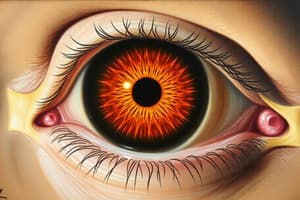Podcast
Questions and Answers
Commotio retinae is characterized by damage to which layers of the eye following blunt trauma?
Commotio retinae is characterized by damage to which layers of the eye following blunt trauma?
- Outer retinal layers (correct)
- Lens fibers
- Corneal endothelial layers
- Inner retinal layers
A patient presents with blurry vision and gray-white opacification of the retina following a sports injury. Which condition is most likely indicated by these symptoms?
A patient presents with blurry vision and gray-white opacification of the retina following a sports injury. Which condition is most likely indicated by these symptoms?
- Chorioretinitis sclopetaria
- Central retinal vein occlusion
- Commotio retinae (correct)
- Optic neuritis
Which of the following is the MOST common cause of limited visual recovery in patients with commotio retinae?
Which of the following is the MOST common cause of limited visual recovery in patients with commotio retinae?
- Late choroidal atrophy
- Extensive peripheral damage
- Macular hole (correct)
- Choroidal rupture
A patient diagnosed with commotio retinae is concerned about long-term vision loss. What is the typical prognosis for visual recovery?
A patient diagnosed with commotio retinae is concerned about long-term vision loss. What is the typical prognosis for visual recovery?
Chorioretinitis sclopetaria is caused by:
Chorioretinitis sclopetaria is caused by:
What distinguishes chorioretinitis sclopetaria from commotio retinae in terms of mechanism of injury?
What distinguishes chorioretinitis sclopetaria from commotio retinae in terms of mechanism of injury?
Which of the following is the MOST likely long-term complication of chorioretinitis sclopetaria?
Which of the following is the MOST likely long-term complication of chorioretinitis sclopetaria?
A patient presents with Purtscher-like retinopathy, but has no history of trauma. Which of the following conditions could be a potential underlying cause?
A patient presents with Purtscher-like retinopathy, but has no history of trauma. Which of the following conditions could be a potential underlying cause?
A patient is diagnosed with Purtscher retinopathy following a traumatic injury. Which of the following represents the most appropriate initial treatment approach?
A patient is diagnosed with Purtscher retinopathy following a traumatic injury. Which of the following represents the most appropriate initial treatment approach?
Valsalva retinopathy is characterized by a sudden increase in pressure. Which of the following correctly describes the primary mechanism by which this condition affects the retina?
Valsalva retinopathy is characterized by a sudden increase in pressure. Which of the following correctly describes the primary mechanism by which this condition affects the retina?
Which of the following activities is least likely to be associated with the development of Valsalva retinopathy?
Which of the following activities is least likely to be associated with the development of Valsalva retinopathy?
A patient with a history of systemic lupus erythematosus (SLE) presents with Purtscher-like retinopathy. What treatment is most likely to be considered in this case?
A patient with a history of systemic lupus erythematosus (SLE) presents with Purtscher-like retinopathy. What treatment is most likely to be considered in this case?
What characteristic of Bruch's membrane and RPE contributes to their rupture in chorioretinitis sclopetaria?
What characteristic of Bruch's membrane and RPE contributes to their rupture in chorioretinitis sclopetaria?
Which mechanism is considered to play a role in the indirect injury observed in chorioretinitis sclopetaria?
Which mechanism is considered to play a role in the indirect injury observed in chorioretinitis sclopetaria?
Why does the sclera typically remain intact in cases of chorioretinitis sclopetaria?
Why does the sclera typically remain intact in cases of chorioretinitis sclopetaria?
Which of the following patient demographics is most likely to be affected by chorioretinitis sclopetaria?
Which of the following patient demographics is most likely to be affected by chorioretinitis sclopetaria?
Which of the following is a common early sign observed in chorioretinitis sclopetaria?
Which of the following is a common early sign observed in chorioretinitis sclopetaria?
What is the appearance of Bruch’s membrane and choriocapillaris breaks after hemorrhage clears in chorioretinitis sclopetaria?
What is the appearance of Bruch’s membrane and choriocapillaris breaks after hemorrhage clears in chorioretinitis sclopetaria?
Which of the following visual acuity (VA) ranges is most likely to be observed in a patient with chorioretinitis sclopetaria?
Which of the following visual acuity (VA) ranges is most likely to be observed in a patient with chorioretinitis sclopetaria?
What is the significance of 'split and retract' in the context of chorioretinitis sclopetaria?
What is the significance of 'split and retract' in the context of chorioretinitis sclopetaria?
In addition to visual acuity loss and hemorrhage, what other clinical sign is commonly associated with chorioretinitis sclopetaria?
In addition to visual acuity loss and hemorrhage, what other clinical sign is commonly associated with chorioretinitis sclopetaria?
What diagnostic procedure is MOST helpful in evaluating the extent of vitreous hemorrhage and ruling out retinal detachment following ocular trauma?
What diagnostic procedure is MOST helpful in evaluating the extent of vitreous hemorrhage and ruling out retinal detachment following ocular trauma?
A patient presents with sudden vision loss after a chest compression injury. Examination reveals multiple patches of superficial retinal whitening and intraretinal hemorrhages. This is MOST consistent with:
A patient presents with sudden vision loss after a chest compression injury. Examination reveals multiple patches of superficial retinal whitening and intraretinal hemorrhages. This is MOST consistent with:
A patient with choroidal rupture is being monitored. What is the MOST significant long-term complication to watch for?
A patient with choroidal rupture is being monitored. What is the MOST significant long-term complication to watch for?
In Purtscher retinopathy, what is the typical timeframe for the progression of fundus changes after the initial trauma?
In Purtscher retinopathy, what is the typical timeframe for the progression of fundus changes after the initial trauma?
Which of the following is a typical finding in fluorescein angiography (FA) for Purtscher retinopathy?
Which of the following is a typical finding in fluorescein angiography (FA) for Purtscher retinopathy?
What is the MOST appropriate management strategy for commotio retinae?
What is the MOST appropriate management strategy for commotio retinae?
A patient diagnosed with Purtscher retinopathy exhibits polygonal areas of retinal whitening with a clear demarcation from normal retinal vessels. This finding is known as:
A patient diagnosed with Purtscher retinopathy exhibits polygonal areas of retinal whitening with a clear demarcation from normal retinal vessels. This finding is known as:
What percentage of Purtscher retinopathy cases result in permanent visual impairment, despite the resolution of acute fundus changes?
What percentage of Purtscher retinopathy cases result in permanent visual impairment, despite the resolution of acute fundus changes?
In optical coherence tomography (OCT) imaging of Purtscher retinopathy, which of the following findings corresponds to cotton-wool spots?
In optical coherence tomography (OCT) imaging of Purtscher retinopathy, which of the following findings corresponds to cotton-wool spots?
In which scenario is surgical intervention MOST likely required following ocular trauma?
In which scenario is surgical intervention MOST likely required following ocular trauma?
What structural change is associated with Purtscher flecken on spectral domain OCT?
What structural change is associated with Purtscher flecken on spectral domain OCT?
What is the underlying mechanism behind Purtscher retinopathy?
What is the underlying mechanism behind Purtscher retinopathy?
A patient presents with Purtscher retinopathy sparing the retina immediately adjacent to the arterioles. Where are the cotton wool spots likely to be?
A patient presents with Purtscher retinopathy sparing the retina immediately adjacent to the arterioles. Where are the cotton wool spots likely to be?
A patient diagnosed with metastatic pancreatic cancer presents with bilateral Purtscher-like retinopathy. What is the significance of cotton-wool spots observed along the arcades and in a peripapillary distribution?
A patient diagnosed with metastatic pancreatic cancer presents with bilateral Purtscher-like retinopathy. What is the significance of cotton-wool spots observed along the arcades and in a peripapillary distribution?
Which of the following findings in ocular trauma has the POOREST visual prognosis?
Which of the following findings in ocular trauma has the POOREST visual prognosis?
What does the presence of Purtscher flecken indicate regarding the retinal layers in a patient with Purtscher-like retinopathy?
What does the presence of Purtscher flecken indicate regarding the retinal layers in a patient with Purtscher-like retinopathy?
Which of the following is a typical characteristic of Purtscher flecken?
Which of the following is a typical characteristic of Purtscher flecken?
In the context of Purtscher retinopathy, how should the prognosis be generally characterized?
In the context of Purtscher retinopathy, how should the prognosis be generally characterized?
How do chronic cases of Purtscher retinopathy affect photoreceptors?
How do chronic cases of Purtscher retinopathy affect photoreceptors?
A patient with a history of significant trauma presents with decreased vision. Fundus examination reveals cotton-wool spots and Purtscher flecken. Which imaging modality would be MOST helpful in further evaluating the retinal changes at the microscopic level?
A patient with a history of significant trauma presents with decreased vision. Fundus examination reveals cotton-wool spots and Purtscher flecken. Which imaging modality would be MOST helpful in further evaluating the retinal changes at the microscopic level?
Flashcards
Commotio Retinae
Commotio Retinae
Traumatic retinopathy caused by blunt trauma to the eye.
Causes of Commotio Retinae
Causes of Commotio Retinae
Direct trauma to the globe from high impact sports, violence, or motor vehicle accidents.
Symptoms of Commotio Retinae
Symptoms of Commotio Retinae
Gray-white opacification with possible vision loss or blurry vision immediately after trauma.
Prognosis of Commotio Retinae
Prognosis of Commotio Retinae
Signup and view all the flashcards
Complications of Commotio Retinae
Complications of Commotio Retinae
Signup and view all the flashcards
Chorioretinitis Sclopetaria
Chorioretinitis Sclopetaria
Signup and view all the flashcards
Visual Outcomes with Trauma
Visual Outcomes with Trauma
Signup and view all the flashcards
Hemorrhage
Hemorrhage
Signup and view all the flashcards
Vision improvement after injury
Vision improvement after injury
Signup and view all the flashcards
Direct injury mechanism
Direct injury mechanism
Signup and view all the flashcards
Indirect injury mechanism
Indirect injury mechanism
Signup and view all the flashcards
Risk factors for ocular injuries
Risk factors for ocular injuries
Signup and view all the flashcards
Signs of retinal injury
Signs of retinal injury
Signup and view all the flashcards
Bruch’s membrane
Bruch’s membrane
Signup and view all the flashcards
Fibrotic scarring
Fibrotic scarring
Signup and view all the flashcards
Purtscher-like Retinopathy
Purtscher-like Retinopathy
Signup and view all the flashcards
Traumatic Causes of Purtscher Retinopathy
Traumatic Causes of Purtscher Retinopathy
Signup and view all the flashcards
Valsalva Retinopathy
Valsalva Retinopathy
Signup and view all the flashcards
Non-Traumatic Conditions
Non-Traumatic Conditions
Signup and view all the flashcards
Treatment for Purtscher Retinopathy
Treatment for Purtscher Retinopathy
Signup and view all the flashcards
CT/Sonogram
CT/Sonogram
Signup and view all the flashcards
OCT
OCT
Signup and view all the flashcards
Choroidal rupture
Choroidal rupture
Signup and view all the flashcards
Significant vision loss
Significant vision loss
Signup and view all the flashcards
Purtscher Retinopathy
Purtscher Retinopathy
Signup and view all the flashcards
Cotton-wool spots
Cotton-wool spots
Signup and view all the flashcards
Putcher flecken
Putcher flecken
Signup and view all the flashcards
Visual loss range
Visual loss range
Signup and view all the flashcards
Secondary choroidal neovascularization
Secondary choroidal neovascularization
Signup and view all the flashcards
Late leakage in FA
Late leakage in FA
Signup and view all the flashcards
Study Notes
Commotio Retinae
- Also known as Berlin's edema
- Traumatic retinopathy due to direct globe trauma
- Common in high-impact sports and motor vehicle accidents
- Damage to outer retinal layers from shock waves
- Retinal whitening appears hours after injury
- Most common in the posterior pole, but possible in periphery
- Macular involvement may cause limited recovery
- Associated with various complications:
- Cystoid macular edema
- Macular hole
- Choroidal rupture
- Macular pigment epitheliopathy
- Symptoms:
- Blurred vision immediately after trauma
- Potential vision loss, decreased VA (visual acuity) as low as 20/200
- Prognosis generally good; resolution expected within weeks.
Chorioretinitis Sclopetaria
- Traumatic chorioretinal rupture or chorioretinitis proliferans
- Uncommon
- Caused by high-velocity projectile injury (e.g., bullet, BB gun) near or through orbit (without penetrating globe).
- Injury leads to a full-thickness chorioretinal defect resulting in vision loss.
- Can cause extensive vitreous and retinal hemorrhages
- Often with delayed, chronic changes of atrophy of pigment, and fibrotic patches in retina
Purtscher Retinopathy
- Characterized by multiple superficial retinal whitening patches, intraretinal hemorrhages, and papillitis.
- Often following severe head trauma, especially chest compression injuries
- Visual acuity loss can range from 20/20 to counting fingers.
- Symptoms include white retinal patches resembling cotton wool spots; superficial peripapillary hemorrhages
- Pathognomonic feature: polygonal areas of retinal whitening.
High Altitude Retinopathy
- Occurs in individuals engaging in vigorous activities at high altitudes.
- Intraretinal hemorrhages, retinal cotton-wool spots also possible optic nerve edema.
- Visual loss may result from increased venous pressure, secondary to the hypoxic environment.
- Generally self-limiting with observation.
Valsalva Retinopathy
- Caused by sudden increases in intrathoracic or intraabdominal pressure.
- Pre-retinal or subhyaloidal hemorrhages.
- Usually secondary to activities like straining during bowel movements, childbirth, or ocular massage
- Hemorrhagic detachment of the internal limiting membrane (ILM)
- Visual acuity varies depending on the extent of the retinal involvement.
Terson Syndrome
- Intraocular hemorrhage associated with subarachnoid hemorrhage.
- Result of increased intracranial pressure causing retinal capillary rupture.
- Hemorrhage typically located in the sub-retinal and sub-ILM areas.
- Visual disturbances range from minor effects to major vision loss.
Shaken Baby Syndrome
- Usually seen in infants and children from inflicted trauma
- Signs including diffuse retinal hemorrhages, macular retinoschisis
- Hemorrhagic macular retinoschisis and retinal hemorrhages
- Often accompanied by other signs of abuse or traumatic brain injury.
- Prognosis varies, but may include cortical blindness in some cases.
- Immediate reporting of suspected abuse to authorities is essential.
Studying That Suits You
Use AI to generate personalized quizzes and flashcards to suit your learning preferences.




